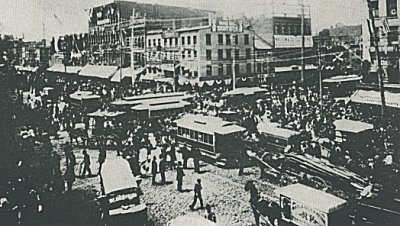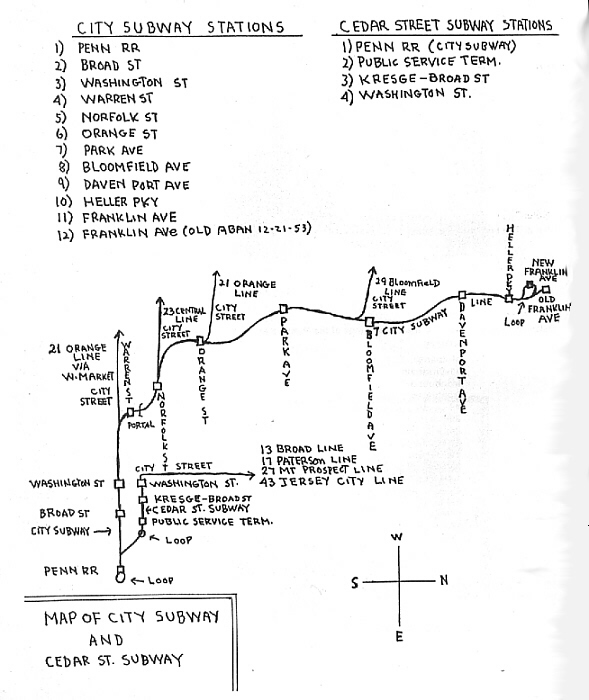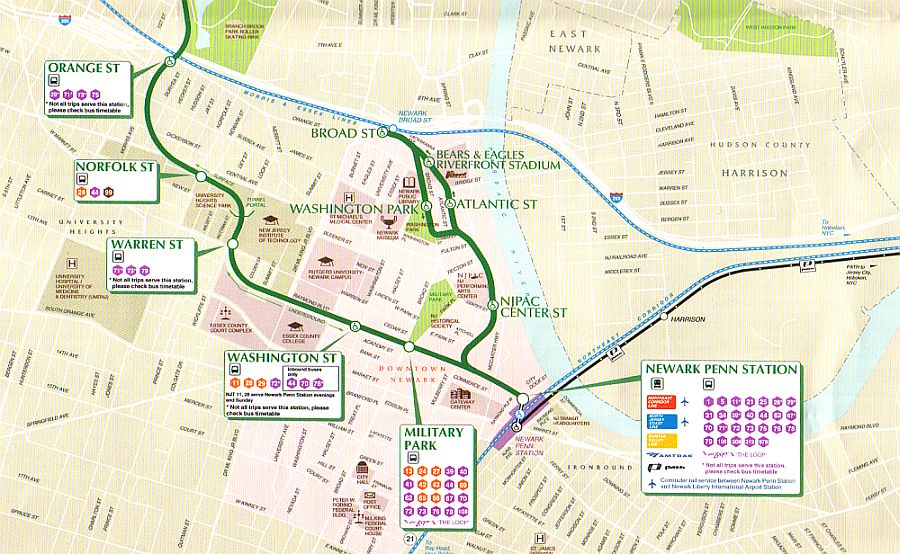 Cedar Street Subway Cedar Street Subway
By the turn of the 20th Century, downtown Newark was a crowded conglomeration of streetcar lines that ran to all corners of the region; Broad and Market (right) was practically impassable at certain times of day. In 1916 Public Service Corporation, which had consolidated the myriad streetcar routes, built a terminal on Park Place, across from Military Park, in a plot of land purchased from PSC's president and chairman of the board, Thomas McCarter. Some lines were routed to an Upper Level via ramp from Mulberry Street, and others to a short subway built between the Lower Level of the terminal and Washington Street, where the cars surfaced and continued at street level. This tunnel ran under Cedar Street, and was called, naturally, the Cedar Street Subway. In 1927 a Broad Street station was built with an entrance into Kresge's department store. A couple years later an outbound platform was built with an entrance from McCrory's five-and-dime store, and not long after, an extension connected the Cedar Street Subway to another congestion-fighting project, the new City Subway. Newark City Subway The NCS was built in the bed of the old Morris Canal, which had been abandoned in 1924. The line's construction began in 1929 and roughly coincided with the rise of the Pennsylvania Railroad's new Penn Station. Originally the NCS ran between Broad Street and Heller Parkway, where the double-ended streetcars pulled into a "Y" siding, switched gears and headed back downtown. Where the line went underground the cut was paved over, and North Canal Street (as the downtown portion of the drained canal was called) became Raymond Boulevard. The main line was completed in 1935, and two years later it was extended to the new Penn Station. Five lines operated in the City Subway: The 21 Orange line via W. Market, which entered the subway between Washington and Warren streets; the 23 Central line, entering at Norfolk Street; another 21 Orange line entering at Orange Street; the 29 Bloomfield line, entering at Bloomfield Avenue, and the 7 City Subway line itself. Three other lines -- the 13 Broad, 27 Mt. Prospect and 43 Jersey City -- used the system for just the short hop between Penn Station and the Cedar Street Subway. Yet, all that having been accomplished, the era of the streetcar was coming to a close. In 1929 the upper level of the PS terminal had been "paved in" to also accommodate trackless trolley and conventional buses, and in 1937 the Cedar Street Subway was given similar treatment. The extension to the City Subway was abandoned. Streetcar operation tailed off almost immediately; trackless trolley -- also known as All-Service Vehicle -- operation continued until 1947, and in 1966 the last bus rolled through the Cedar Street Subway, which was then shut down permanently. The upper level had been closed in 1961, and in 1981 the Public Service building itself was demolished after the company moved to new quarters. Plans for also paving over the City Subway were made, but the cost proved prohibitive. One improvement was made in 1940, when thanks to a WPA project the line was extended to Franklin Avenue. But by this time the suburbs through which the old streetcars continuously clacked were pressuring Public Service to get rid of the tracks that were holding up progress on their boulevards; unfortunately, at the same time the oil and tire barons' campaign to make the electric streetcar extinct had come to Newark, so starting in 1947 the lines using the City Subway were switched to diesel buses and rerouted to surface streets-- ironically returning Newark to its previous condition of downtown congestion. The last 21 Orange car (of Newark's first and oldest streetcar line) took its last trip down Orange Street in 1952, and now only the 7 line itself was operating in the City Subway. Then, faced with the choice of updating its rail equipment or abandoning the subway entirely, PS followed public sentiment and in 1954 purchased 30 PCC cars from the Twin Cities transit system, which also had "gone diesel." This sleek art-deco electric streetcar had been designed in the early '30s by the President's Conference Committee of the American Railway Association, a confederation of streetcar operators and manufacturers, and can still be found in many transit systems around the world. Because the cars were single-ended, turnaround loops were built at a new Franklin Avenue terminus and at Penn Station, where new maintenance bays were also installed. With those improvements, the City Subway as most of us remember it was completed. The PCC cars rumbled faithfully through the city until 2001, when new light-rail vehicles replaced them. At the same time, the Heller Parkway Station was closed, the Franklin Avenue Station became Branch Brook Park Station, and work began on extending the line. New stations were built at Silverlake (Belleville) and Grove Street (Bloomfield), the latter also home to a new storage/maintenance facility. So whence the mighty PCCs? Out of the fleet, 11 cars were sent to San Francisco, where they are being modified and put into regular service. Seven went to Bayonne for service at the former Military Ocean Terminal, to be rehabilitated and run on a 2.5 mile loop at the city's "Peninsula at Bayonne Harbor," a mixed-use site, and will connect to the 34th St. station of the HBLRT via a pedestrian walkway. At the Grove Street car barn, five PCCs remain. One is #16, a work car that NJT is retaining. Car #1 is promised to the City of Newark for a historical exhibition yet to be detailed. Cars # 5, 6 and 10 are destined for that state transportation museum planned for Phillipsburg. In 2006, 70 years after its opening, the
Newark City Subway -- now renamed "Newark Light
Rail" -- was extended from Penn Station to
the New Jersey Transit Broad Street Station,
using part of the original Public Service Building
connection. The line surfaces alongside
McCarter Highway and passes the Newark Riverfront
Stadium and Performing Arts Center before
terminating at the old Delaware, Lackawanna &
Western station and returning via Broad Street,
past Washington Park, to the main line. NJT,
which took over the subway from Public Service,
plans to eventually tie the line in to the North
Jersey light rail system that will run from
Bayonne and Elizabeth to Bergen County.
|

